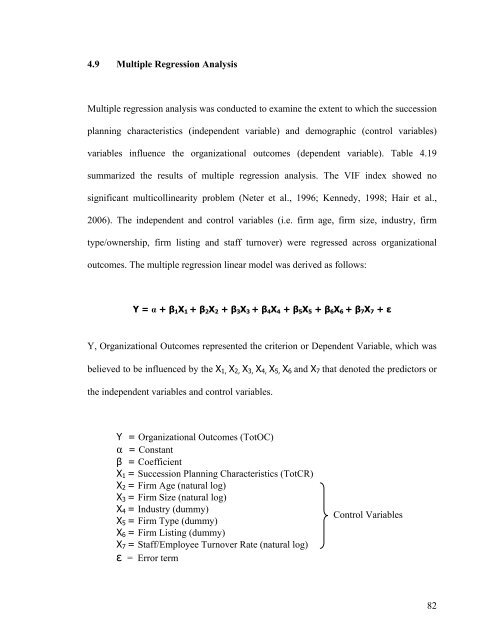CHAPTER 1: INTRODUCTION 1.0 Chapter Overview - DSpace@UM
CHAPTER 1: INTRODUCTION 1.0 Chapter Overview - DSpace@UM
CHAPTER 1: INTRODUCTION 1.0 Chapter Overview - DSpace@UM
Create successful ePaper yourself
Turn your PDF publications into a flip-book with our unique Google optimized e-Paper software.
4.9 Multiple Regression AnalysisMultiple regression analysis was conducted to examine the extent to which the successionplanning characteristics (independent variable) and demographic (control variables)variables influence the organizational outcomes (dependent variable). Table 4.19summarized the results of multiple regression analysis. The VIF index showed nosignificant multicollinearity problem (Neter et al., 1996; Kennedy, 1998; Hair et al.,2006). The independent and control variables (i.e. firm age, firm size, industry, firmtype/ownership, firm listing and staff turnover) were regressed across organizationaloutcomes. The multiple regression linear model was derived as follows:Y = α + β 1 X 1 + β 2 X 2 + β 3 X 3 + β 4 X 4 + β 5 X 5 + β 6 X 6 + β 7 X 7 + εY, Organizational Outcomes represented the criterion or Dependent Variable, which wasbelieved to be influenced by the X 1, X 2, X 3, X 4, X 5, X 6 and X 7 that denoted the predictors orthe independent variables and control variables.Y = Organizational Outcomes (TotOC)α = Constantβ = CoefficientX 1 = Succession Planning Characteristics (TotCR)X 2 = Firm Age (natural log)X 3 = Firm Size (natural log)X 4 = Industry (dummy)X 5 = Firm Type (dummy)X 6 = Firm Listing (dummy)X 7 = Staff/Employee Turnover Rate (natural log)ε = Error termControl Variables82
















